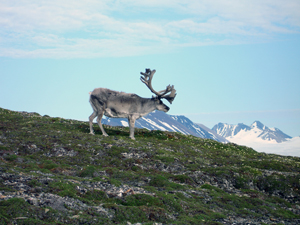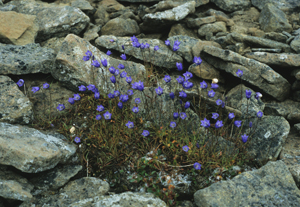Isfjorden's vegetation
By Øystein Overrein
 Moors of mountain avens are a good place for reindeer to graze. (Image: Lise Øvrum / The Governor of Svalbard) Moors of mountain avens are a good place for reindeer to graze. (Image: Lise Øvrum / The Governor of Svalbard)
 Arctic bluebells in the valley Colesdalen. (Image: Øystein Overrein / The Norwegian Polar Institute) Arctic bluebells in the valley Colesdalen. (Image: Øystein Overrein / The Norwegian Polar Institute)
 Reinrosehei in Ekmanfjorden. (Image: Anders Skoglund/ The Norwegian Polar Institute) Reinrosehei in Ekmanfjorden. (Image: Anders Skoglund/ The Norwegian Polar Institute)
In terms of vegetation, there is high diversity in Isfjorden. Variations in climate and substrates account for this. The surrounding area is one of the lushest areas in Svalbard, and endangered and vulnerable plants are found at many sites here. In fact, more than three-quarters of Svalbard’s vascular plants can be found in Isfjorden, where the vegetation in general is denser than any other place in the archipelago. A vegetation typical of the northern Arctic tundra zone characterizes the outer areas of Isfjorden, a region that is moist, boggy and distinguishable by the fact that Arctic wood-rush (Luzula nivalis) and northern wood-rush (Luzula confusa) grow here. As one travels further into the fjord, more thermophilic (warm-loving) vegetation can be found: the mid-Arctic tundra zone vegetation here is largely characterized by Arctic bell-heather (Cassiope tetragona). This is the same kind of vegetation that can be found on the plains in the north of Isfjorden, to the east of Ekmanfjorden. Calcium-rich fens can be found on Bohemanflya and in several places to the east of Ekmanfjorden, close to Kapp Thordsen. There are also large, fertile areas here that are species rich, with denser vegetation, and where cloudberries (Rubus chamaemorus) grow. By Sauriedalen and Kapp Thordsen there are large areas with thick turf. The vegetation in the salt marshes is particularly well developed at Kapp Wijk. Arctic bell-heather tundra dominates the south of the fjord all the way to Sassenfjorden.
By the mouth of the river Adventelva there are unstable sediments surrounded by mountain avens (Dryas octopetala) tundra on moist calcarious soil. The inner parts of Isfjorden offer a better climate for thermophilous species. Dry barren ridges of mountain avens exist in the eastern and inner parts of Billefjorden. This kind of vegetation is also common in the valley Gipsdalen and on both sides of the fjord Tempelfjorden. The warmest climate is in the banks facing south, where species familiar from the mainland are found: dwarf Arctic birch (Betula nana ssp. tundrarum), crowberry (Empetrum nigrum ssp. hermaphroditum), the rare Arctic bluebell (Campanula rotundifolia ssp. gieseckiana) and polar bilberry (Vaccinium uliginosum ssp. microphyllum).
|